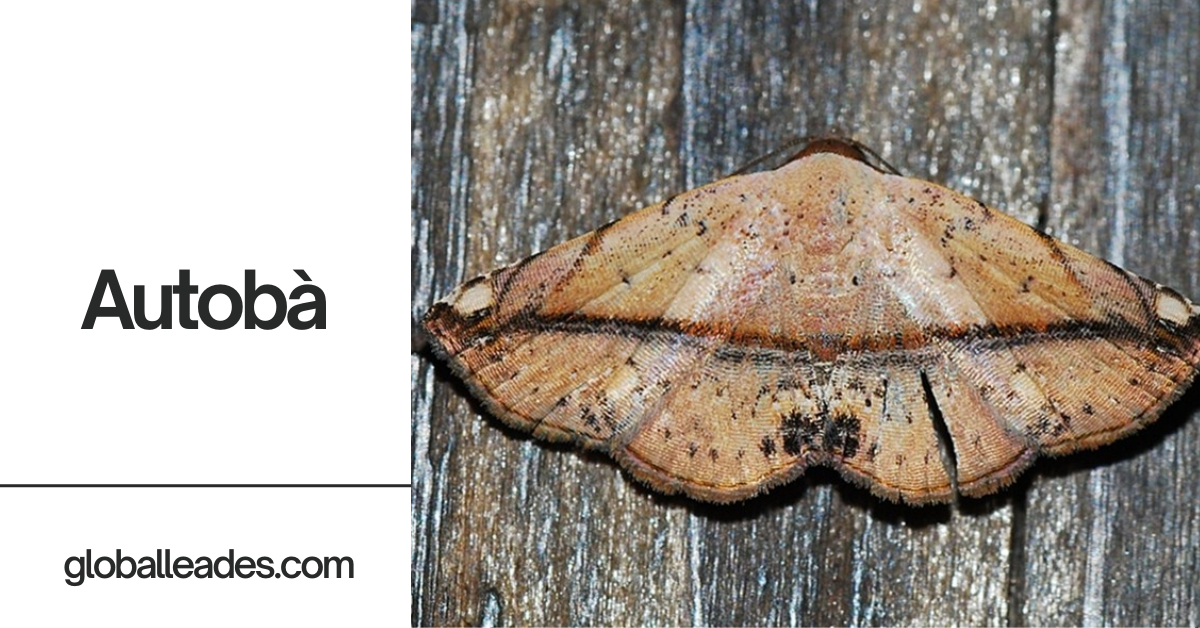In the vast and diverse world of insects, moths often get overlooked in favor of their flashier cousins, butterflies.
However, moths like Autobà are hidden gems, boasting unique characteristics and fascinating behaviors that deserve our attention.
In this article, we’ll delve into the captivating world of Autobà moths, exploring their history, taxonomy, morphology, habits, and ecological significance.
What is Autobà?
Autobà is a genus of moths belonging to the family Erebidae, erected by renowned British entomologist Francis Walker in 1863. The name “Autobà” is derived from the Greek words “autos” meaning “self” and “ba” meaning “step” or “walk”, likely referring to the moths’ distinctive gait or movement patterns.
With over 100 species spread across Asia and Africa, Autobà moths are typically small to medium-sized, showcasing a diverse range of colors, patterns, and markings on their wings and bodies.
These nocturnal creatures are attracted to light sources and are often found in proximity to their food sources, which include various plants and fruits.
Despite their modest appearance, Autobà moths have evolved unique adaptations and strategies to survive and thrive in their environments, making them a fascinating subject for study and exploration.
History of Autobà
The history of Autobà moths dates back to the mid-19th century when Francis Walker, a British entomologist, first described the genus in 1863. Walker, a prominent figure in the field of entomology, was working at the British Museum at the time, cataloging and studying various insect specimens collected from around the world.
Also Read: BagelTechNews .com tech updates In 2024
During his research, he identified a distinct group of moths that shared common characteristics, leading him to establish the Autobà genus. Since then, numerous species have been added to the genus, with contributions from entomologists worldwide.
The study of Autobà moths has continued to evolve, with advances in taxonomy, ecology, and conservation biology shedding light on the intricate lives of these fascinating insects.
Today, Autobà remains an important genus in the scientific community, with ongoing research and discoveries further illuminating our understanding of these remarkable moths.
Taxonomy and Classification
Taxonomy and Classification of Autobà Moths
Autobà moths belong to the following taxonomic hierarchy:
- Kingdom: Animalia
- Phylum: Arthropoda
- Class: Insecta
- Order: Lepidoptera
- Family: Erebidae
- Genus: Autobà
- Species: Over 100 species, including:
- Autobà albistriga
- Autobà angulata
- Autobà costimacula
- Autobà flavida
- Autobà humilis
The classification of Autobà moths is based on their morphological characteristics, such as:
- Wing shape and pattern
- Body size and coloration
- Antennae and leg structure
- Genitalia and other reproductive features
The genus Autobà is divided into several species groups, each containing species with shared characteristics. The taxonomy of Autobà moths is constantly being refined as new research and discoveries are made, providing a deeper understanding of the relationships between these fascinating insects.
Morphological Characteristics of Autobà Moths
Autobà moths exhibit the following morphological characteristics:
Also Read: TheSportsHouse.net Pendridge – Your Ultimate Guide In 2024
Wings:
- Medium to large size ( wingspan: 20-40 mm)
- Triangular shape with rounded tips
- Forewings with distinctive markings and patterns
- Hindwings with a uniform color or subtle patterns
Body:
- Small to medium size (body length: 10-20 mm)
- Elongated shape with a rounded abdomen
- Covered with tiny scales and hairs
- Colors range from brown, gray, to white and yellow
Head and Antennae:
- Head small with a distinctive snout-like projection
- Antennae long and slender with a club-like tip
Legs and Feet:
- Legs slender with distinctive spines and hairs
- Feet with specialized claws for perching and walking
Eyes:
- Large compound eyes with thousands of lenses
- Eyespots present on hindwings in some species
Other Features:
- Proboscis long and coiled for feeding on nectar
- Abdomen with distinctive tufts of hair or scales
These morphological characteristics are essential for identifying Autobà moths and understanding their adaptations to their environment.
Habitat and Distribution
Autobà moths are found in a variety of habitats across Asia and Africa, including tropical forests, grasslands, and urban areas. They are widely distributed, with species found in countries such as India, China, Japan, Indonesia, and Madagascar.
Also Read: Spicyrranny – Guideline The Fusion of Flavors In 2024
These moths are attracted to light sources and are often found near artificial lights, flowers, and fruit-bearing plants. They are also drawn to dark, damp areas with high humidity, such as caves and rock crevices.
Some species of Autobà moths are migratory, traveling long distances in search of food and suitable habitats. Overall, the diverse habitats and distribution of Autobà moths reflect their adaptability and ability to thrive in a range of environments.
Behavior and Life Cycle
Behavior and Life Cycle of Autobà Moths
Autobà moths exhibit unique behaviors and undergo a fascinating life cycle:
Adult Behavior:
- Nocturnal, active at night, and attracted to light sources
- Feed on nectar from flowers and fruits
- Males engage in territorial displays, flapping wings and releasing pheromones
- Females choose mates based on courtship displays and pheromone signals
Life Cycle:
- Eggs: Females lay eggs on leaves or stems, which hatch into larvae in 3-5 days
- Larvae (Caterpillars): Feed on plants, grow, and molt several times over 2-4 weeks
- Pupae: Larvae enter a pupal stage, transforming into adult moths in 2-4 weeks
- Adults: Emerge from pupae, mate, and start the cycle anew
Unique Behaviors:
- Some Autobà species exhibit a “freeze” behavior when threatened, remaining still and camouflaged
- Others display a “flash” behavior, rapidly flashing their wings to deter predators
The life cycle and behaviors of Autobà moths are intricately linked, with each stage influencing the next, and adaptations honed to ensure survival and reproduction in their environments.
Ecological Role and Impact
Autobà moths play a significant ecological role in their respective habitats, serving as important pollinators and seed dispersers for various plant species. As adults, they feed on nectar, transferring pollen between flowers, and facilitating the reproduction of plants.
Also Read: Kääntäminen – Understanding the Basics of Translation In 2024
Additionally, their larvae (caterpillars) act as herbivores, consuming plant leaves and stems, influencing plant growth and development. Some Autobà species are specialized to feed on specific plants, developing unique adaptations to exploit these resources.
By controlling plant populations and shaping vegetation structures, Autobà moths contribute to maintaining the balance and diversity of their ecosystems.
Moreover, they serve as a food source for various predators, such as birds, bats, and spiders, supporting the complex food webs in their habitats. Overall, the ecological impact of Autobà moths is substantial, highlighting the importance of these insects in maintaining the health and resilience of ecosystems.
Interesting Facts and Trivia
- Bioluminescence: Some Autobà species have specialized light-producing organs, emitting a glowing glow to attract mates or defend territories.
- Mimicry: Certain Autobà moths mimic the appearance and behavior of toxic or distasteful insects, deterring predators from attacking them.
- Camouflage: Autobà moths have evolved impressive camouflage strategies, blending into their surroundings to avoid detection.
- Long-distance migration: Some Autobà species migrate hundreds of miles each year, crossing entire countries or even continents.
- Unique antennae: Autobà moths have distinctive, feathery antennae that help them detect pheromones and navigate their environment.
- Important pollinators: Like bees, Autobà moths are significant pollinators, transferring pollen between flowers as they feed on nectar.
- Food source: Autobà moths are an essential food source for various animals, including birds, bats, and spiders.
- Cultural significance: In some cultures, Autobà moths are considered symbols of good luck, prosperity, or transformation.
Conservation Status and Threats
Autobà moths face significant conservation threats, including habitat destruction and fragmentation, pesticide use, and climate change impacts.
The destruction of natural habitats and the widespread use of pesticides have led to dramatic population declines, with some species experiencing declines of up to 90%. Climate change also poses a significant threat, as changes in temperature and precipitation patterns disrupt the delicate relationships between Autobà moths and their food sources.
Also Read: How to Incorporate Geöe into Your Life In 2024
Additionally, light pollution from urban areas attracts and disorients Autobà moths, further threatening their survival. As a result, many Autobà species are now considered endangered or vulnerable, and conservation efforts are necessary to protect these fascinating insects and the ecosystems they inhabit.
Challenges in Studying Moths
- Taxonomic complexity: Moths are incredibly diverse, with over 160,000 known species, making identification and classification challenging.
- Nocturnal behavior: Moths are active at night, making observation and study more difficult.
- Small size: Many moth species are tiny, requiring specialized equipment for handling and observation.
- Short adult lifespan: Adult moths often live only a few days or weeks, limiting study windows.
- Larval stages: Caterpillars can be difficult to identify and study due to their small size and variable appearances.
- Habitat and distribution: Moths inhabit diverse habitats, making fieldwork and sampling challenging.
- Behavioral observations: Studying moth behavior, especially at night, can be difficult and requires specialized techniques.
- Funding and resources: Research on moths often receives less funding and attention than other insects, like bees or butterflies.
Despite these challenges, scientists continue to develop innovative methods and technologies to study moths, advancing our understanding of these fascinating insects.
Technological Advancements in Entomology
Technological advancements have revolutionized the field of entomology, enabling scientists to study insects with unprecedented precision and efficiency. Computational biology and bioinformatics have facilitated the analysis of vast amounts of data, while 3D imaging technologies like IBIS have enabled the sharing and comparison of insect specimens across networks.
Also Read: превоодач – Mastering the Art of Translation
Omics techniques, such as genomics and proteomics, have revealed intricate details about insect biology, and sensitive detection methods like mass spectrometry have enabled the detection of minute substances. Artificial intelligence has been applied to analyze crime scenes and compare fingerprint data, while nanosensors have been developed to detect illegal drugs and biological agents.
Additionally, innovative tools like the Foldscope, a portable and affordable paper microscope, have democratized access to entomological research, allowing scientists to make on-the-spot determinations in the field.
These technological breakthroughs have transformed our understanding of insects and have far-reaching implications for fields like agriculture, conservation, and forensic science.
Conclusion
In conclusion, Autobà moths are fascinating insects that play a vital role in our ecosystem. Their unique characteristics, behaviors, and adaptations make them an important subject of study in entomology.
Despite the challenges in studying moths, technological advancements have greatly aided in advancing our understanding of these insects.
The significance of Autobà moths extends beyond their ecological role, as they also have cultural and economic importance.
Also Read: Ontpresscom – Reliable Source In 2024
It is essential to continue researching and conserving these insects to ensure the health of our planet and its biodiversity.
By acknowledging the importance of Autobà moths and other insects, we can work towards a future where we coexist with these vital creatures.
FAQs
What is the average lifespan of an Autobà moth?
The average lifespan of an Autobà moth is approximately 1-2 weeks, although some species can live up to 6 weeks. Factors like food availability and predation can affect their lifespan.
Do Autobà moths have any natural predators?
Yes, Autobà moths have several natural predators, including birds, bats, spiders, and other insects like dragonflies and lacewings. These predators play a crucial role in maintaining the ecological balance.
Can Autobà moths fly long distances?
Some Autobà moth species are capable of flying long distances, up to 100 km or more, in search of food, shelter, or mates. This impressive ability helps them colonize new areas and adapt to changing environments.
Are Autobà moths attracted to sweet substances?
Yes, many Autobà moth species are attracted to sweet substances like nectar, honey, and fruit juices. This attraction helps them locate food sources and navigate their environment.
Do Autobà moths have any economic importance?
Autobà moths have significant economic importance, as some species are used in biological control programs to manage pest populations, while others are used in the production of silk, dyes, and other products.
Can Autobà moths hear sounds?
Some Autobà moth species have hearing organs that allow them to detect sounds, like the ultrasonic calls of bats, which helps them avoid predators and navigate their environment.
Do Autobà moths have any cultural significance?
Autobà moths have cultural significance in some societies, where they are considered symbols of good luck, prosperity, or transformation. In some cultures, they are also used in traditional medicine and rituals.




